Integrating Strategies Aimed at Biodiversity and Water Resource Sustainability in the Amazonian Region
Abstract
1. Introduction
2. Methodology
2.1. Type of Research
2.2. Featuring the Study Site
2.3. Data Collection
3. Results and Discussion
3.1. Biodiversity in the Amazonian Region
3.2. Water Resources in the Amazonian Region
3.3. Degradation Factors in the Amazonian Region
3.4. Integrative Review on Biodiversity and Water Resources Conservation in the Amazonian Region
4. Conclusions and Policy Implication
Author Contributions
Funding
Institutional Review Board Statement
Informed Consent Statement
Data Availability Statement
Conflicts of Interest
References
- Guayasamin, J.; Ribas, C.; Carnaval, A.; Carrillo, J.; Hoorn, C.; Lohmann, L.; Riff, D.; Ulloa, C.; Albert, J. Evolution of Amazonian biodiversity: A review. Acta Amaz. 2024, 54, e54bc21360. [Google Scholar] [CrossRef]
- Ter Steege, H.; Ptman, N.C.A.; Sabatier, D.; Baraloto, C.; Salomão, R.P.; Guevara, J.E.; Philips, O.; Castilho, C.V.; Magnusson, W.E.; Molino, J.-F.; et al. Hyperdominance in the Amazonian tree flora. Science 2013, 342, 1243092. [Google Scholar] [CrossRef]
- Albert, J.S.; Carnaval, A.C.; Flantua, S.G.A.; Lohmann, L.G.; Ribas, C.C.; Riff, D.; Carrilo, J.D.; Fan, Y.; Figueiredo, J.P.; Guayasamin, J.M.; et al. Human impacts outpace natural processes in the Amazon. Science 2023, 379, eabo5003. [Google Scholar] [CrossRef]
- Amaral, M.F.; Ascencio, C.L.; Cristóbal, E.P. Los riesgos climáticos de la amazonía enmarcados por el periodismo independiente. HALAC 2024, 14, 137–161. [Google Scholar] [CrossRef]
- Lapola, D.; Pinho, P.; Barlow, J.; Aragão, L.E.O.C.; Berenguer, E.; Carmenta, R.; Liddy, H.M.; Seixas, H.; Silva, C.V.J.; Silva, C.H.L., Jr.; et al. The drivers and impacts of Amazon forest degradation. Science 2023, 379, eabp8622. [Google Scholar] [CrossRef]
- Li, W.; Duveiller, G.; Wieneke, S.; Forkel, M.; Gentine, P.; Reichstein, M.; Niu, S.; Migliavacca, M.; Orth, R. Regulation of the global carbon and water cycles through vegetation structural and physiological dynamics. Environ. Res. Lett. 2024, 19, 073008. [Google Scholar] [CrossRef]
- Santos, J.V.A.S.; Lima, M.; Monteles, J.S.; Carrera, D.L.R.; Faria, P.J.; Brasil, L.S.; Juen, L. Assessing physical habitat structure and biological condition in eastern Amazonia stream sites. Water Biol. Secur. 2023, 2, 100132. [Google Scholar] [CrossRef]
- Brasil, L.S.; Lima, E.L.; Spigoloni, Z.A.; Ribeiro-Brasil, D.R.G.; Juen, L. The Habitat Integrity Index and aquatic insect communities in tropical streams: A meta-analysis. Ecol. Indic. 2020, 116, 106495. [Google Scholar] [CrossRef]
- Rocha, G.C.; Sánchez-Román, R.M.; Folegatti, M.V.; Lino, J.S. Aspectos físicos e sociais da geografia da disponibilidade hídrica municipal no Brasil. Irriga 2013, 18, 402–414. [Google Scholar] [CrossRef]
- Okumura, A.T.R.; Silva, A.G.; Silva, N.R.S.; Lopes, E.R.N.; Bifano, R.B.A.; Quilenato, R.V. Determinação da qualidade da água de um rio tropical sob a perspectiva do uso. Rev. Bras. Geogr. Física 2020, 13, 1835–1850. [Google Scholar] [CrossRef]
- Ferreira, S.; De Lima, A.; Corrêa, J. Indicators of hydrological sustainability, governance and water resource regulation in the Moju river basin (PA)—Eastern Amazonia. J. Environ. Manag. 2020, 263, 110354. [Google Scholar] [CrossRef] [PubMed]
- Sant’anna, F.M. Governança Multiescalar dos Recursos Hídricos Transfronteiriços na Amazônia; Editora Unesp: São Paulo, Brazil, 2017. [Google Scholar]
- Abreu, W.L.; Basso, L.A.; Costa, D.C.L. Recursos hídricos na Amazônia brasileira orientada pela inteligência artificial. Res. Soc. Dev. 2022, 11, e34311830707. [Google Scholar] [CrossRef]
- Marcovitch, J.; Pinsky, V. Bioma Amazônia: Atos e fatos. Estud. Avançados 2020, 34, 83–106. [Google Scholar] [CrossRef]
- Stegmann, L.F.; França, F.M.; Carvalho, R.L.; Barlow, J.; Berenguer, E.; Castello, L.; Juen, L.; Baccaro, F.B.; Vieira, I.C.G.; Nunes, C.A.; et al. Brazilian public funding for biodiversity research in the Amazon. Perspect. Ecol. Conserv. 2024, 22, 1–7. [Google Scholar] [CrossRef]
- Artaxo, P.; Rizzo, L.V.; Machado, L.A.T. Inteligência Artificial e Mudanças Climáticas. Rev. USP 2024, 141, 29–40. [Google Scholar] [CrossRef]
- Rorato, A.; Picoli, M.; Verstegen, J.; Câmara, G.; Bezerra, F.; Escada, M. Environmental Threats over Amazonian Indigenous Lands. Land 2021, 10, 267. [Google Scholar] [CrossRef]
- Moura, A.M.M. Governança Ambiental no Brasil: Instituições, Atores e Políticas Públicas; Ipea: Brasília, Brazil, 2016. [Google Scholar]
- Adams, C.; Borges, Z.; Moretto, E.M.; Futemma, C. Governança ambiental no Brasil: Acelerando em direção aos objetivos de desenvolvimento sustentável ou olhando pelo retrovisor? Cad. Gestão Pública Cid. 2020, 25, e-81403. [Google Scholar] [CrossRef]
- Alves, A.O.; Azevedo, T.C. Governança ambiental e desafios socioambientais contemporâneos: Uma análise da evolução da gestão pública. Rev. Desenvolv. Econômico 2023, 25, 51–78. [Google Scholar] [CrossRef]
- Jacobi, P.R.; Sinisgalli, P.A.A. Governaça ambiental e economia verde. Ciência Saúde Coletiva 2012, 17, 1469–1478. [Google Scholar] [CrossRef]
- Cravo, C.F.; Cerqueira, L.S. Governança ambiental no âmbito local: Análise de gestão de conflitos socioambientais em Rio Grande—RS. Rev. Desenvolv. Econômico 2022, 2, 242–273. [Google Scholar] [CrossRef]
- Strong. O Que é Governança Ambiental? 2024. Available online: https://abrir.link/bRuUC (accessed on 29 December 2024).
- Chizzotti, A. Pesquisa em Ciências Humanas e Sociais; Cortez: São Paulo, Brazil, 2018. [Google Scholar]
- Gil, A.C. Métodos e Técnicas de Pesquisa Social; Atlas: São Paulo, Brazil, 2019. [Google Scholar]
- Richardson, R.J. Pesquisa Social: Métodos e Técnicas; Atlas: São Paulo, Brazil, 2017. [Google Scholar]
- MapBiomas. The Mapping of the Amazonin the MapBiomas Project. 2023. Available online: https://brasil.mapbiomas.org/wp-content/uploads/sites/4/2024/10/Factsheet-Amazonia_C9_01.10_v2.pdf (accessed on 29 December 2024).
- Souza, M.T.; Silva, M.D.; Carvalho, R. Revisão integrativa: O que é e como fazer. Einstein 2010, 8, 102–106. [Google Scholar] [CrossRef] [PubMed]
- Hayec, F.A.V. A Pretensão do Conhecimento; LVM: São Paulo, Brazil, 2019. [Google Scholar]
- Affonso, E.P. A Insciência do Usuário na Fase de Coleta de Dados. Ph.D. Thesis, Universidade Estadual Paulista, Marília, Brazil, 2018. [Google Scholar]
- Page, M.J.; McKenzie, J.E.; Bossuyt, P.M.; Boutron, I.; Hoffmann, T.C.; Mulrow, C.D.; Shamseer, L.; Tetzlaff, J.M.; Akl, E.A.; Brennan, S.E.; et al. The PRISMA 2020 statement: An updated guideline for reporting systematic reviews. BMJ 2021, 372, 71. [Google Scholar] [CrossRef] [PubMed]
- Fearnside, P. The intrinsic value of Amazon biodiversity. Biodivers. Conserv. 2021, 30, 1199–1202. [Google Scholar] [CrossRef]
- World Bank. A Importância Fundamental da Biodiversidade da Amazônia para o Mundo. 2019. Available online: https://abrir.link/PpsFH (accessed on 15 August 2024).
- Lopes, M.J.S.; Santiago, B.S.; Silva, I.N.B.; Gurgel, E.S.C. Impacto do desmatamento e queimadas na biodiversidade invisível da Amazônia. Rev. Agronegócio Meio Ambiente RAMA 2023, 16, e9608. [Google Scholar]
- Nannipieri, P.; Ascher-Jenull, J.; Ceccherini, M.T.; Pietramellara, G.; Renella, G.; Schloter, M. Beyond microbial diversity for predicting soil functions: A mini review. Pedosphere 2020, 30, 5–17. [Google Scholar] [CrossRef]
- Xu, X.; Zhang, X.; Riley, W.J.; Xue, Y.; Nobre, C.A.; Lovejoy, T.E.; Jia, G. Deforestation triggering irreversible transition in Amazon hydrological cycle. Environ. Res. Lett. 2022, 17, 034037. [Google Scholar] [CrossRef]
- Castello, L.; McGrath, D.G.; Hess, L.L.; Coe, M.T.; Lefebvre, P.A.; Petry, P.; Macedo, M.N.; Renó, V.F.; Arantes, C.C. The vulnerability of Amazon freshwater ecosystems. Conserv. Lett. 2013, 6, 217–229. [Google Scholar] [CrossRef]
- Garcia, T.; Benone, N.L.; Prudente, B.S.; Torres, N.R.; Bunn, S.E.; Kennard, M.J.; Montag, L.F.A. The influence of landscape at multiple spatial scales of the river basins at the Eastern Amazon fish assemblage. Neotrop. Ichthyol. 2023, 21, e220044. [Google Scholar] [CrossRef]
- Duarte, C.M.; Reckermann, M. Amazonian aquatic ecosystems and their role in biogeochemical cycles. Biogeosciences 2023, 20, 1339–1359. [Google Scholar]
- IPBES—Plataforma Intergovernamental de Ciência e Política Sobre Biodiversidade e Serviços Ecossistêmicos. 1º Diagnóstico Brasileiro de Biodiversidade e Serviços Ecossistêmicos. 2019. Available online: https://abrir.link/GXsGl (accessed on 15 August 2024).
- Ratcliffe, S.; Wirth, C.; Jucker, T.; Van der Plas, F.; Scherer-Lorenzen, M.; Verheyen, K.; Allan, E.; Benavides, R.; Bruelheide, H.; Ohse, B.; et al. Biodiversity and ecosystem functioning relations in European forests depend on environmental context. Ecol. Lett. 2017, 20, 1414–1426. [Google Scholar] [CrossRef]
- Artaxo, P. As três emergências que nossa sociedade enfrenta: Saúde, biodiversidade e mudanças climáticas. Estud. Avançados 2020, 34, 53–66. [Google Scholar] [CrossRef]
- Esquivel, M.J.; Silva, A.L. The Amazon Basin: A Review of its Ecological and Socioeconomic Importance. J. Trop. Ecol. 2024, 40, 234–245. [Google Scholar]
- Wikipédia. Amazon River Basin. 2025. Available online: https://pt.wikipedia.org/wiki/Bacia_do_rio_Amazonas (accessed on 9 March 2025).
- Checon, H.; Costa, H.H.R.; Corte, G.N.; Souza, F.M.; Pombo, M. Rainfall Influences the Patterns of Diversity and Species Distribution in Sandy Beaches of the Amazon Coast. Sustainability 2023, 15, 5417. [Google Scholar] [CrossRef]
- Costa, M.H.; Borma, L.; Brando, P.M.; Marengo, J.A.; Saleska, S.R.; Gatti, L.V. Chapter 7: Biogeophysical Cycles: Water Recycling, Climate Regulation. In Amazon Assessment Report 2021; United Nations Sustainable Development Solutions Network: New York, NY, USA, 2021; Available online: https://www.theamazonwewant.org/spa-reports/ (accessed on 5 January 2025).
- Ribeiro, C.; Mohanty, B.P.; Rotuni Filho, O.C.; Filgueiras, E.T.; Xavier, L.N.R.; Araújo, A.A.M. Water Balance and the moist planetary boundary layer driven by land use and land cover change across the Amazon basin. Water 2023, 15, 4052. [Google Scholar] [CrossRef]
- Pereira Júnior, A.; Morales, G.P.; Beltrão, N.E.S. Riparian vegetation, permanent protection area and water quality in the paraense Amazon. Concilium 2023, 23, 712–728. [Google Scholar] [CrossRef]
- Fleischmann, A.; Papa, F.; Hamilton, S.K.; Andrade, A.F.; Wongchuig, S.; Espinoza, J.C.; Paiva, R.C.D.; Melack, J.M.; Chouinard, E.F.; Castello, L. Increased floodplain inundation in the Amazon since 1980. Environ. Res. Lett. 2023, 18, 4024. [Google Scholar] [CrossRef]
- Fearnside, P.M. Deforestation in Brazilian Amazonia: History, rates, and consequences. Conserv. Biol. 2023, 19, 680–688. [Google Scholar] [CrossRef]
- Fearnside, P.M. O Desmatamento da Amazônia Brasileira: 11–Pecuária. 2020. Available online: https://abrir.link/qExft (accessed on 23 April 2024).
- Flores, B.M.; Montoya, E.; Sakschewski, B.; Nascimento, N.; Staal, A.; Betts, R.A.; Levis, C.; Lapola, D.M.; Muelbert, A.E.; Jakovac, C.; et al. Critical transitions in the Amazon forest system. Nature 2024, 626, 555–564. [Google Scholar] [CrossRef]
- Nobre, A.D. O Futuro Climático da Amazônia: Relatório de Avaliação Científica; ARA/INPE: Manaus, Brazil, 2018. [Google Scholar]
- Batista, L.F.; Nascimento, T.S.R.; Costa, I.; Correa, E.S.; Monte, C.N. Change in water quality in an Amazonian microbasin: Ecological and human health implications. J. Water Health 2024, 22, 522–535. [Google Scholar] [CrossRef]
- Couto, R.C.S. Saúde e ambiente na Amazônia brasileira. Novos Cad. NAEA 2020, 23, 167–178. [Google Scholar] [CrossRef]
- Sorribas, M.V.; Paiva, R.C.D.; Melack, J.M.; Bravo, J.M.; Jones, C.; Carvalho, L.M.V.; Beighley, E.; Forsberg, B.R.; Costa, M.H. Projeções dos efeitos das mudanças climáticas na descarga e inundação na bacia amazônica. Clim. Change 2016, 136, 555–570. [Google Scholar] [CrossRef]
- Caldas, B.; Thieme, L.M.; Shahbol, N.; Coleho, M.E.; Grill, G.; Van Damme, P.A.; Aranha, R.; Cañas, C.; Fagundes, C.K.; Franco-León, N.; et al. Identifying the current and future status of freshwater connectivity corridors in the Amazon Basin. Conserv. Sci. Pract. 2023, 5, e12853. [Google Scholar] [CrossRef]
- Ioris, A.A.R. Water and Energy Frontiers in the Amazon. In Frontier Making in the Amazon; Springer: Cham, Switzerland, 2020. [Google Scholar]
- Souza, C.A.; Oliveira, E.S., Jr.; Hacon, S.S. Serviços ecossistêmicos da Amazônia brasileira. Rev. Bras. Geogr. Física 2024, 17, 178–198. [Google Scholar] [CrossRef]
- Gonçalves, M.S.; Mezzomo, M.D.M.; Gonçalves, M.S. Nascentes Riscos e Impactos; UTFPR: Campo Mourão, Brazil, 2020. [Google Scholar]
- Heerspink, B.P.; Kendall, A.D.; Coe, M.T.; Hyndman, D.W. Trends in streamflow, evapotranspiration, and groundwaterstorage across the Amazon Basin linked to changing precipitation and land cover. J. Hydrol. Reg. Stud. 2020, 32, e100755. [Google Scholar] [CrossRef]
- Kohler, M.R.; Bampi, A.C.; Silva, C.A.F.; Arantes, A.; Gaspar, W.J. Deforestation in the Brazilian Amazon from the perspective of cattle ranching. Res. Soc. Dev. 2021, 10, e66101119252. [Google Scholar] [CrossRef]
- Bush, M.B. New and Repeating Tipping Points: The Interplay of Fire, Climate Change, and Deforestation in Neotropical Ecosystems. Ann. Mo. Bot. Gard. 2020, 105, 393–404. [Google Scholar] [CrossRef]
- Biggs, T.W.; Santiago, T.M.O.; Sills, E.; Harris, J.C. The Brazilian Forest Code and riparian preservation areas: Spatiotemporal analysis and implications for hydrological ecosystem services. Reg. Environ. Change 2019, 8, 2381–2394. [Google Scholar] [CrossRef]
- Hänggli, A.; Levi, S.A.; Armenteras, D.; Bovolo, I.; Brandão, J.; Rueda, X.; Garrett, R.D. A systematic comparison of deforestation drivers and policy effectiveness across the Amazon biome. Environ. Res. Lett. 2023, 18, 073001. [Google Scholar] [CrossRef]
- Assunção, J.; Gandour, C.; Rocha, R. DETER-ing Deforestation in the Amazon: Environmental Monitoring and Law Enforcement. Am. Econ. J. Appl. Econ. 2023, 15, 125–156. [Google Scholar] [CrossRef]
- Teixeira, T.A.; Vilaça, N.L.; Printes, A.L.; Gomes, R.C.S.; Torné, I.G.; Araújo, T.-Y.A.; Dias, A.G.D. Development of a Monitoring System against Illegal Deforestation in the Amazon Rainforest Using Artificial Intelligence Algorithms. Eng. Proc. 2023, 58, 21. [Google Scholar] [CrossRef]
- Soubry, I.; Doan, T.; Chu, T.; Guo, X. A Systematic Review on the Integration of Remote Sensing and GIS to Forest and Grassland Ecosystem Health Attributes, Indicators, and Measures. Remote Sens. 2021, 13, 3262. [Google Scholar] [CrossRef]
- Guayasamin, J.M.; Ribas, C.C.; Carnaval, A.C.; Carrillo, J.D.; Hoorn, C.; Lohmann, L.G.; Riff, D.; Ulloa, C.; Albert, J.S. Chapter 2: Evolution of Amazonian Biodiversity. In Amazon Assessment Report 2021; United Nations Sustainable Development Solutions Network: New York, NY, USA, 2021; Available online: https://www.theamazonwewant.org/spa-reports/ (accessed on 5 January 2025).
- Zapata-Ríos, G.; Andreazzi, C.S.; Carnaval, A.C.; Doria, C.R.C.; Duponchelle, F.; Flecker, A.; Guayasamín, J.M.; Heilpern, S.; Jenkins, C.N.; Maldonado, C.; et al. Chapter 3: Biological Diversity and Ecological Networks in the Amazon. In Amazon Assessment Report 2021; United Nations Sustainable Development Solutions Network: New York, NY, USA, 2021; Available online: https://www.theamazonwewant.org/spa-reports/ (accessed on 5 January 2025).
- Doblas, J.; Reis, M.; Mérmoz, S.; Almeida, C.; Koleck, T.; Messias, C.; Soler, L.; Bouvet, A.; Sant’Anna, S. DETER-RT: The new INPE-TropiSCO deforestation monitoring system in the Amazon biome. Int. Arch. Photogramm. Remote Sens. Spat. Inf. Sci. 2024, 48, 127–133. [Google Scholar] [CrossRef]
- Andela, N.; Morton, D.; Schroeder, W.; Chen, Y.; Brando, P.; Randerson, J. Tracking and classifying Amazon fire events in near real time. Sci. Adv. 2022, 8, eabd2713. [Google Scholar] [CrossRef] [PubMed]
- Chazdon, R.L.; Guariguata, M.R. Ecological Restoration in the Amazon: Challenges and Opportunities. Biol. Conserv. 2023, 274, 109–123. [Google Scholar]
- Calandino, D.; Scárdua, F.P.; Koblitz, R.V. Participação social, uma aliada na conservação da biodiversidade em unidades de conservação da Amazônia. Divers. Gestão 2018, 2, 151–177. [Google Scholar]
- Perz, S.; Arteaga, M.; Farah, A.; Brown, I.; Mendoza, E.; Paula, Y.; Yabar, L.; Pimentel, A.; Ribeiro, S.; Rioja-Ballivián, G.; et al. Participatory Action Research for Conservation and Development: Experiences from the Amazon. Sustainability 2022, 14, 233. [Google Scholar] [CrossRef]
- Dawson, N.M.; Coolsaet, B.; Sterling, E.J.; Loveridge, R.; Gross-Camp, N.D.; Wongbusarakum, S.; Sangha, K.K.; Scherl, L.M.; Phuong Phan, H.; Zafra-Calvo, N.; et al. The role of Indigenous peoples and local communities in effective and equitable conservation. Ecol. Soc. 2021, 26, 19. [Google Scholar] [CrossRef]
- Stabile, M.; García, A.; Salomão, C.; Bush, G.; Guimarães, A.; Moutinho, P. Slowing deforestation in the brazilian Amazon: Avoiding legal deforestation by compensating farmers and ranchers. Front. For. Glob. Chang. 2022, 4, 635638. [Google Scholar] [CrossRef]
- Silveira, J.; Neto, S.; Cantó, A.; Leite, F.; Cordeiro, F.; Assad, L.; Silva, G.; Marques, R.; Dalarme, M.; Ferreira, I.; et al. Land Use, Land Cover Change and Sustainable Intensification of Agriculture and Livestock in the Amazon and the Atlantic Forest in Brazil. Sustainability 2022, 14, 2563. [Google Scholar] [CrossRef]
- Dablin, L.; Lewis, S.; Milliken, W.; Monro, A.; Lee, M. Browse from three tree legumes increases forage production for cattle in a silvopastoral system in the Southwest Amazon. Animals 2021, 11, 3585. [Google Scholar] [CrossRef]
- Nunes, S.S.; Barlow, J.; Gardner, T.A.; Siqueira, J.V.; Sales, M.R.; Souza, C., Jr. A 22 year assessment of deforestation and restoration in riparian forests in the eastern Brazilian Amazon. Environ. Conserv. 2014, 42, 193–203. [Google Scholar] [CrossRef]
- Couto, T.; Jenkins, C.; Beveridge, C.; Heilpern, S.; Herrera, R.G.; Piland, N.; Leal, C.; Zuanon, J.; Doria, C.; Montoya, M.; et al. Translating science into actions to conserve Amazonian freshwaters. Conserv. Sci. Pract. 2024, 6, e13241. [Google Scholar] [CrossRef]
- Guimarães, M.; Souza, M. Water-Energy-Food-Forest Nexus in The Amazon Conservation Unit. Rev. Gestão Soc. Ambient. 2024, 18, e07599. [Google Scholar] [CrossRef]
- Almeida, S.; Silva, E. A brief account of the 2030 agenda and its implications for Brazil and the Amazon Region in achieving Sustainable Development Goal 6: Clean Water and Sanitation. Int. J. Adv. Eng. Res. Sci. 2022, 9, 90–95. [Google Scholar] [CrossRef]
- Steinke, V.A.; Pessoa, G.E.; Silva, R.G.P.; Saito, C.H. Conceptual and methodological foundations for the articulation of geospatial data on water resources in South America’s cross-border hydrographic basins. Water 2022, 14, 2427. [Google Scholar] [CrossRef]
- Zanin, P.; Cavalcante, R.; Fleischmann, A.; Peres, C.; Ferreira, D.; Oliveira Serrão, E.; Pontes, P. Do protected areas enhance surface water quality across the Brazilian Amazon? J. Nat. Conserv. 2024, 81, 126684. [Google Scholar] [CrossRef]
- Silva, C.H.L., Jr.; Aragão, L.E.O.C.; Anderson, L.O.; Fonseca, M.G.; Shimabukuro, Y.E.; Vancutsem, C.; Achard, F.; Beuchle, F.A.R.; Numara, I.; Saatchi, S.; et al. Persistent collapse of biomass in Amazonian forest edges following deforestation leads to unaccounted carbono losses. Sci. Adv. 2020, 6, eaaz8360. [Google Scholar] [CrossRef]
- Shubo, T.; Fernandes, L.; Montenegro, S.G. An Overview of Managed Aquifer Recharge in Brazil. Water 2020, 12, 1072. [Google Scholar] [CrossRef]
- Saraiva, W. The importance of environmental education in the school context in Amazonas. Rev. Gênero Interdiscip. 2023, 4, 426–437. [Google Scholar]
- Souza, A.M.F.; Pereira, S.F.P.; Santos, L.P.; Silva, C.S.; Rocha, R.M.; Sousa, R.M.; Nogueira, D.P. Software for calculating a water quality indicator specific to the Amazon region. Int. J. Res. 2021, 9, 248–261. [Google Scholar] [CrossRef]
- Flecker, A.; Shi, Q.; Almeida, R.M.; Angarita, H.; Gomes-Selman, J.M.; Garcia-Villacorta, R.; Sethi, S.A.; Thomas, S.A.; Poff, N.L.; Forsberg, B.R.; et al. Reducing adverse impacts of Amazon hydropower expansion. Science 2022, 375, 753–760. [Google Scholar] [CrossRef] [PubMed]
- Fassoni-Andrade, A.; Fleischmann, A.; Papa, F.; Paiva, R.; Wongchuig, S.; Melack, J.; Moreira, A.; Paris, A.; Ruhoff, A.; Barbosa, C.; et al. Amazon hydrology from space: Scientific advances and future challenges. Rev. Geophys. 2021, 59, 1–158. [Google Scholar] [CrossRef]
- Wongchuig, S.; Paiva, R.; Siqueira, V.; Papa, F.; Fleischmann, A.; Biancamaria, S.; Paris, A.; Parrens, M.; Bitar, A. Multi-Satellite Data Assimilation for Large-Scale Hydrological-Hydrodynamic Prediction: Proof of Concept in the Amazon Basin. Water Resour. Res. 2024, 9, 1–34. [Google Scholar] [CrossRef]
- Meneses, H.D.N.M.; Oliveira-da-Costa, M.; Basta, P.C.; Morais, C.G.; Pereira, R.J.B.; Souza, S.M.S.; Hacon, S.S. Mercury Contamination: A Growing Threat to Riverine and Urban Communities in the Brazilian Amazon. Int. J. Environ. Res. Public Health 2022, 19, 2816. [Google Scholar] [CrossRef]
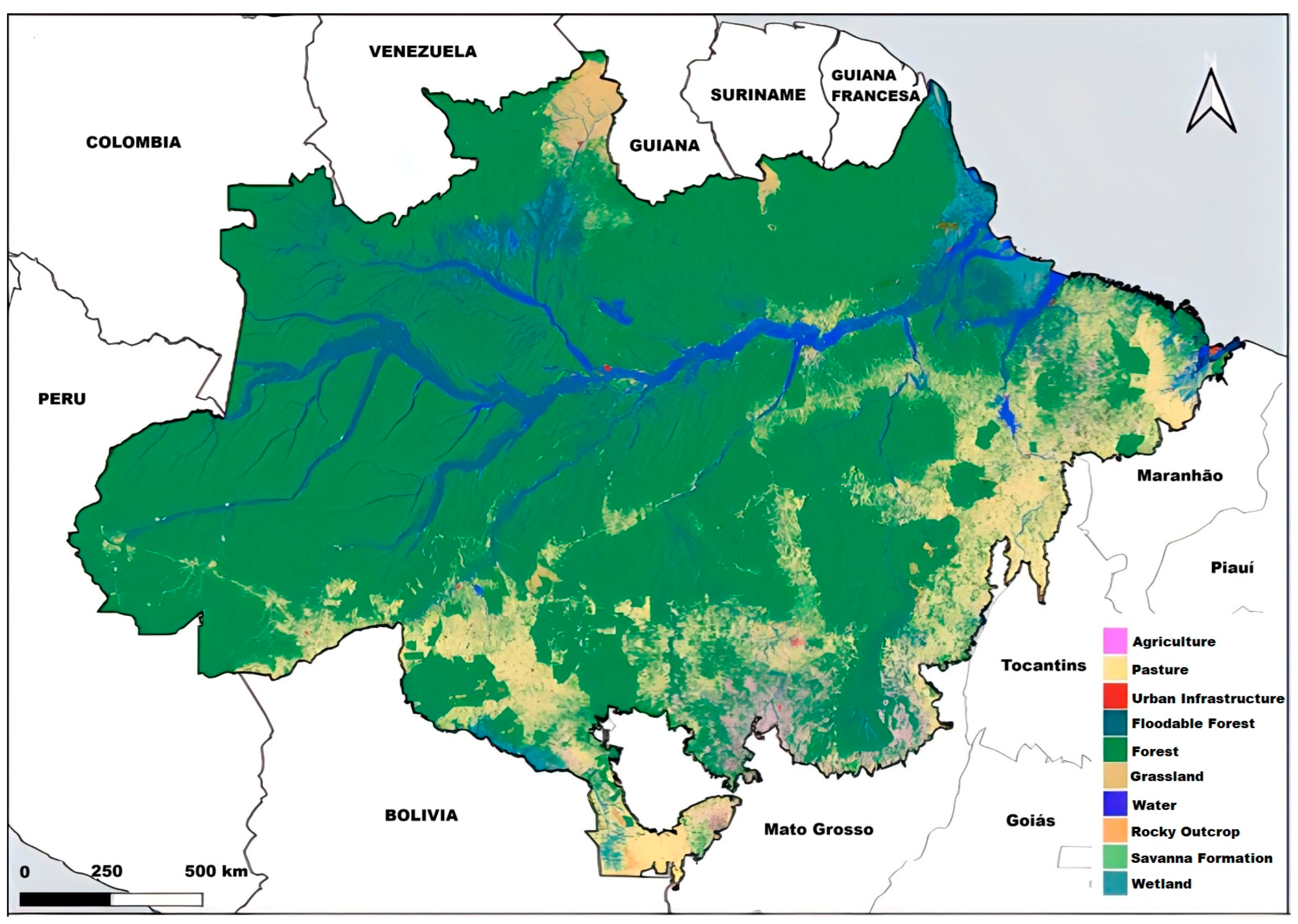
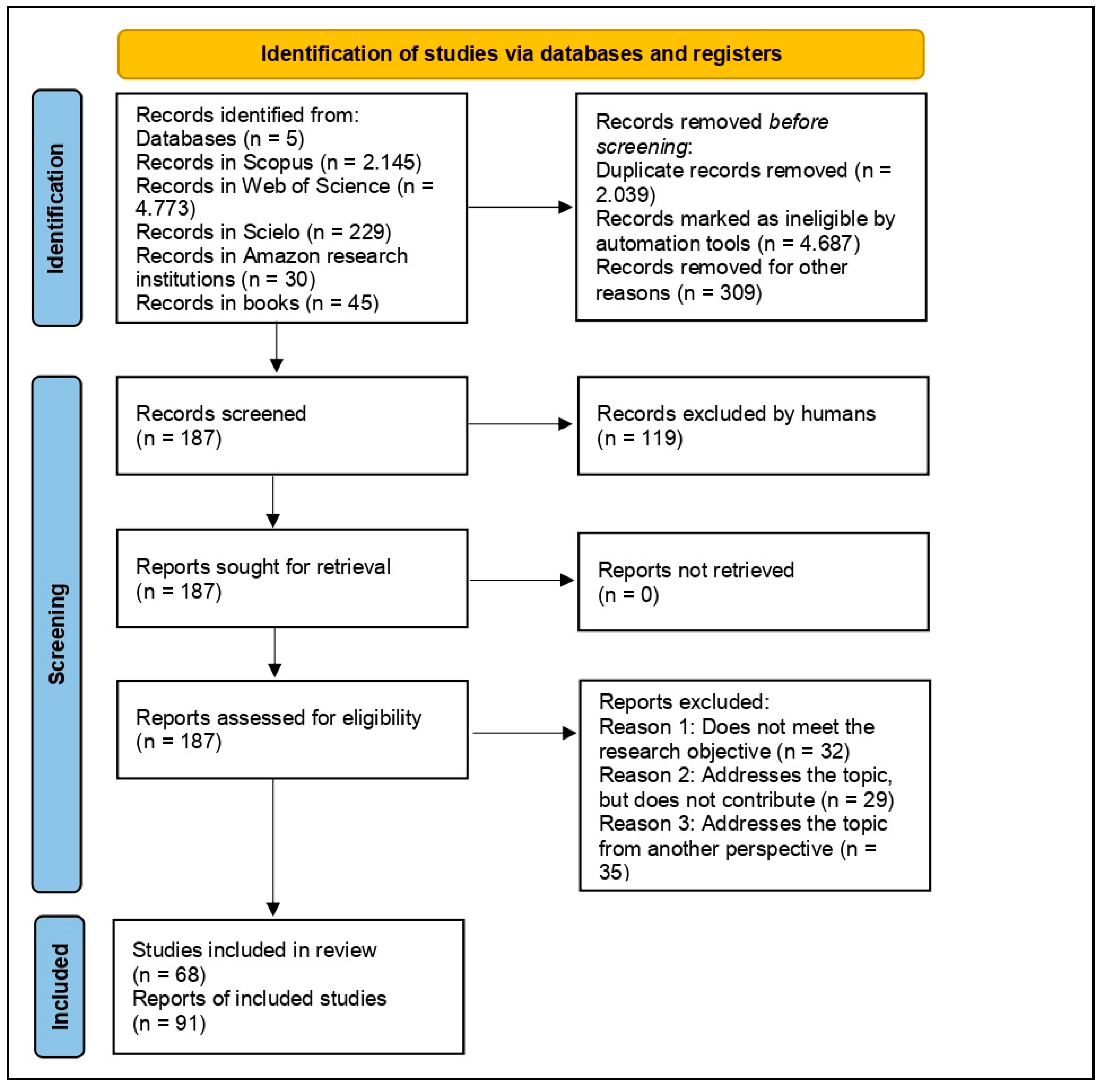
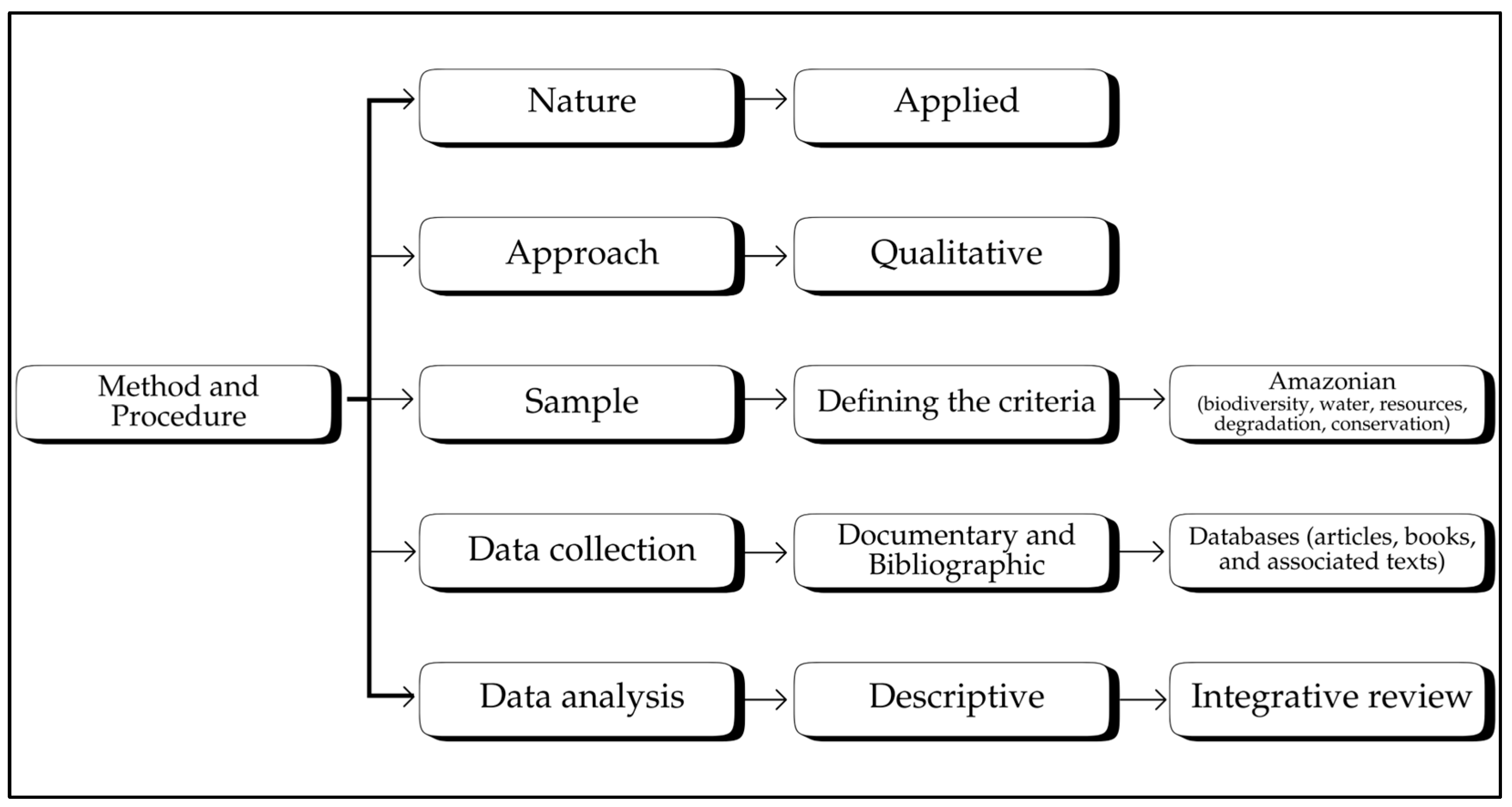

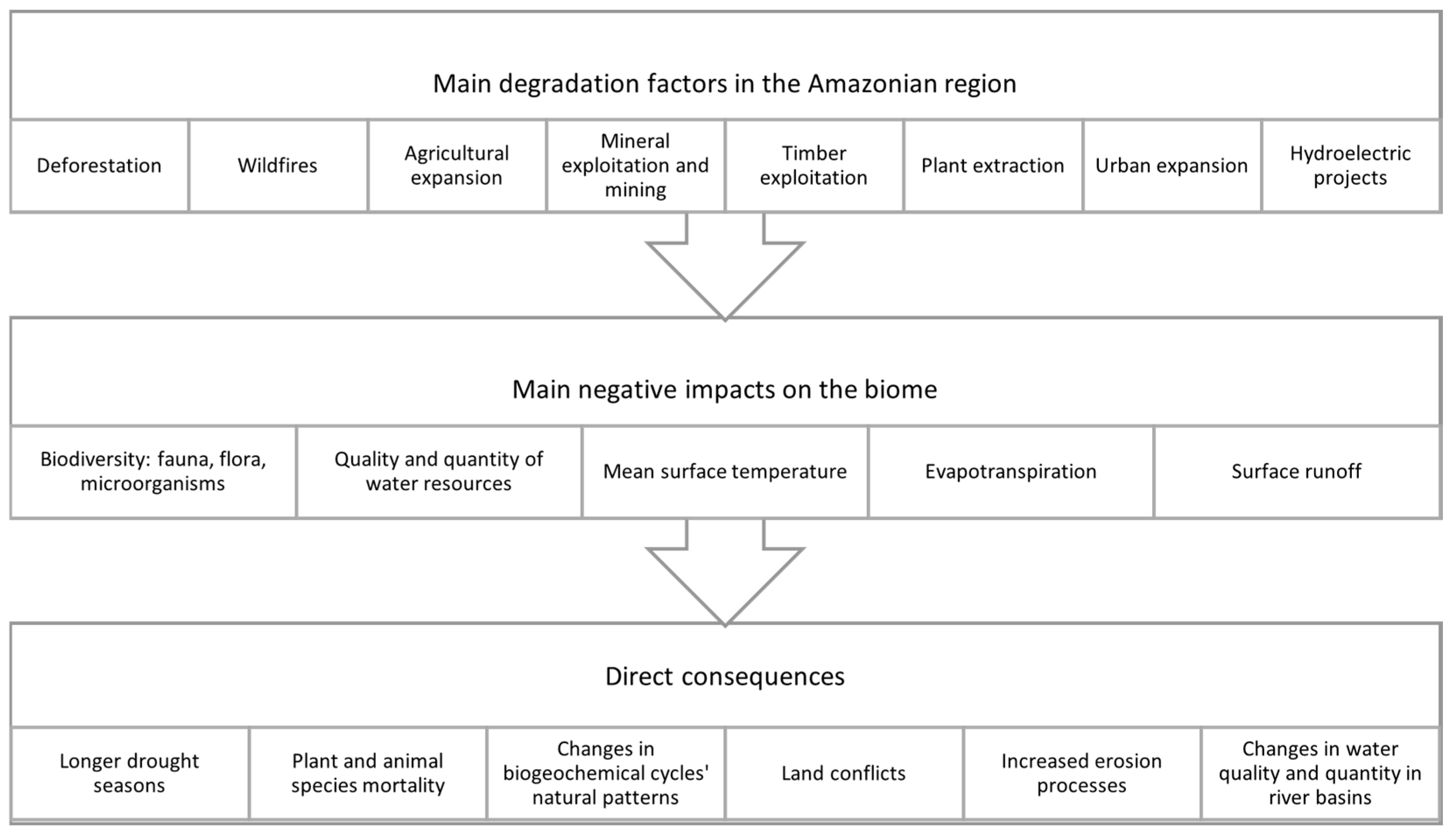
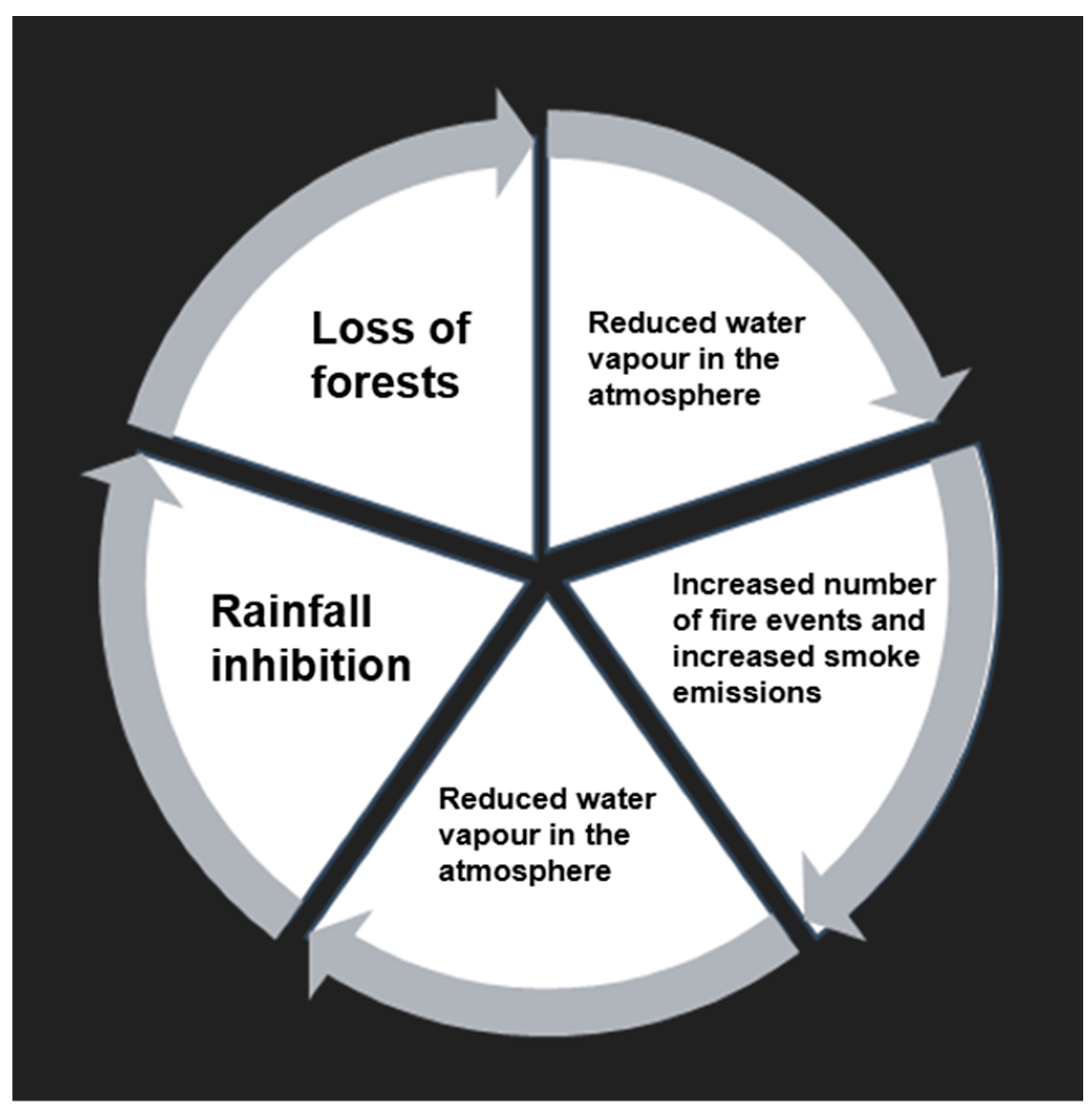

| Elements of Environmental Governance | Description |
|---|---|
| Environmental policies | Environmental policies define the guidelines and stakeholders’ commitment to environmental management. They establish sustainability goals, guidelines for natural resources’ use and strategies to mitigate environmental impacts. Environmental policies are the very basis of environmental governance because they drive stakeholders’ activities and make sure that all involved levels are in line with sustainability goals. |
| Natural resource management | Efficient management of natural resources is essential to reduce the environmental impact. This process includes practices such as water resources’ conservation and rational use, biodiversity conservation, and sustainable management of forests and other renewable resources. Adopting green technologies and innovation also plays a key role in both improving efficiency and minimizing environmental impacts. |
| Reducing greenhouse gas emissions | One of the main goals of environmental governance is to reduce pollutant emissions and waste production. Actors involved in the environmental governance process must implement strategies to minimize greenhouse gas emissions, control air and water pollution, and reduce the amount of produced solid waste. This target can be reached by adopting cleaner production processes and addressing the causes of GHG emissions. |
| Monitoring and reporting | Continuously monitoring environmental impacts is essential to ensure the effectiveness of environmental governance practices. Actors should monitor key environmental performance indicators. Furthermore, transparency is essential. Actors should disclose their environmental results in studies and reports to allow stakeholders and society to assess the performance of monitoring objects. |
| Databases | Keywords | Articles Found in Preliminary Search | Articles Considered After Filtering |
|---|---|---|---|
| Scopus | Biodiversity in the Amazon | 898 | 5 |
| Water resources in the Amazon | 169 | 5 | |
| Degradation factors in the Amazon | 114 | 5 | |
| Biodiversity conservation in the Amazon | 831 | 7 | |
| Water resources conservation in the Amazon | 133 | 12 | |
| Web of Science | Biodiversity in the Amazon | 1810 | 2 |
| Water resources in the Amazon | 1107 | 2 | |
| Degradation factors in the Amazon | 159 | 5 | |
| Biodiversity conservation in the Amazon | 1491 | 3 | |
| Water resources conservation in the Amazon | 206 | 5 | |
| Scielo | Biodiversity in the Amazon | 156 | 2 |
| Water resources in the Amazon | 19 | 0 | |
| Degradation in the Amazon | 4 | 2 | |
| Biodiversity conservation in the Amazon | 46 | 1 | |
| Water resources conservation in the Amazon | 4 | 2 | |
| Research platform | keywords | Texts/books found in preliminary search | Texts taken into consideration after filtering |
| Research institutions on the Amazon | Biodiversity in the Amazon | 6 | 2 |
| Water resources in the Amazon | 6 | 1 | |
| Degradation factors in the Amazon | 6 | 2 | |
| Biodiversity conservation in the Amazon | 6 | 0 | |
| Water resources conservation in the Amazon | 6 | 0 | |
| Books by Brazilian authors who conduct research on the Amazon | Biodiversity in the Amazon | 11 | 0 |
| Water resources in the Amazon | 9 | 1 | |
| Degradation factors in the Amazon | 13 | 2 | |
| Biodiversity conservation in the Amazon | 7 | 2 | |
| Water resources conservation in the Amazon | 5 | 0 |
| Conservation Factor | Mitigation Strategies |
|---|---|
| Biodiversity Reason for conserving: Conserving biodiversity in the Amazonian region is a sine qua non to help maintain living conditions in this biome and on the planet. | Implementing and reinforcing public policies and environmental legislation to help strengthen the application of environmental laws and increase control over deforestation, logging, and illegal mining activities [64]. |
| Satellite monitoring and surveillance, as well as the use of artificial intelligence to identify and punish illegal deforestation activities in real time [65,66]. | |
| Monitoring scientific studies that help us understand changes in terrestrial and aquatic ecosystems in order to adjust conservation strategies. Moreover, constant monitoring of Amazonian biodiversity based on using technologies, such as drones and geographic information systems [67,68]. | |
| The Amazon is home to a vast number of species, many of which are threatened. Understanding the interactions between species and ecological processes is vital to maintaining the resilience of the ecosystem. In the Amazon biome, there are considerable gaps in the understanding of population ecology and the taxonomic and geographical knowledge of species, fundamental elements for preserving biodiversity. Efforts to identify priority areas for multi-species inventories are crucial for improving taxonomic knowledge and mapping species distributions in order to formulate biodiversity conservation policies [69,70]. | |
| Improving fire prevention and control strategies by developing and implementing advanced monitoring systems to identify and respond to wildfire events right away [71]. This process comprises using satellite technologies and early warning systems [72]. | |
| Promoting projects aimed at the reforestation and recovery of deforested areas by restoring forest cover and biodiversity. Ecological restoration projects contribute to restoring essential habitats for biodiversity in the Amazonian region. This process can include replanting native species and removing the invasive ones [73]. | |
| Maintaining permanent preservation areas, Legal Reserves, and Conservation Units, based on society’s participation in this process, and increasing the effectiveness of Conservation Unit management councils to help conserve biodiversity [74]. | |
| Participatory Action Research (PAR) can be used as an efficient strategy for preserving biodiversity and promoting sustainable development in the Amazon. This type of research involves the participation of local stakeholders in data collection and environmental monitoring [75]. | |
| Engaging in and helping local communities and Indigenous peoples to protect and sustainably manage forests by respecting Amazonian peoples’ traditional knowledge [76]. | |
| Economic incentives for conservation processes, based on implementing financial compensation mechanisms for local farmers and communities that adopt sustainable land-use practices and preserve forest areas [77]. | |
| Promoting sustainable agricultural practices, such as conservation agriculture, no-till farming techniques, and crop rotation to help reduce the need for wildfires [78]. | |
| Promoting livestock practices to minimize environmental impact and to reduce the need for expanding the livestock farming area [79]. |
| Conservation Factor | Mitigation Strategies |
|---|---|
| Water resources Reason for conserving: It is essential to conserve water resources in the Amazonian region to help maintain biodiversity, local communities’ well-being, and climate stability. | Maintaining and restoring riparian forests along rivers and streams to protect watercourses from erosion and pollution, and to preserve aquatic biodiversity [47,80]. |
| Recent research has pointed to crucial measures, such as enforcing environmental flows, improving water quality, preserving and restoring vital habitats, managing the exploitation of freshwater organisms, preventing and controlling invasive species, and safeguarding and restoring freshwater connectivity, so that Amazonian water resources are preserved [81]. | |
| Implementing integrated water resource management systems to balance water use and preservation by taking into account both human needs and ecological requirements [56]. | |
| Promoting the water–energy–food–forest nexus is crucial to promoting water resources in the Amazon. Maintaining forest resources improves water quality, controls erosion, and increases resilience against droughts and floods. Appropriate management practices are needed to protect and conserve the quantity and quality of rivers and lakes and the aquatic ecosystems of the biome [82]. | |
| Investing in water infrastructure and sewage treatment systems in urban areas. Monitoring industrial effluent discharges [83]. | |
| Establishing guidelines focused on effective management processes in the Amazon river basin, based on steady methods, databases, regulatory instruments, and on a coordinating body [84]. It is necessary to establish integrated environmental and water management policies [85]. | |
| Mitigating deforestation and wildfire events to help minimize their impact on water resources’ quality and quantity [86]. | |
| Identifying and protecting aquifer recharge areas to maintain groundwater availability, which is essential for communities and ecosystems in the investigated region [87]. | |
| Promoting environmental education and involving local communities in water conservation processes can increase awareness about, and collaboration in, sustainable practices [88]. | |
| Carrying out continuous monitoring and scientific research to track the quality and quantity of water resources, to identify emerging issues and to adjust conservation strategies, whenever necessary [89]. | |
| Using satellite remote sensing to monitor and better understand water cycles and hydrological processes in the Amazonian region [90]. The use of satellite-based remote sensing has supported new research and important discoveries about the Amazon’s water cycle, contributing to a better understanding of the water balance and aquatic environments [91]. | |
| Carefully assessing the environmental and social impacts associated with the expansion of hydroelectric power plants in the Amazonian region, from multiple perspectives [92]. | |
| Developing and implementing continuous monitoring systems to identify and control pollution sources, such as mercury deriving from illegal mining, to help mitigate environmental and public health impacts [93]. | |
| Encouraging agricultural and land management practices to minimize water resource degradation and pollution issues caused by fertilizers and pesticides [78]. |
Disclaimer/Publisher’s Note: The statements, opinions and data contained in all publications are solely those of the individual author(s) and contributor(s) and not of MDPI and/or the editor(s). MDPI and/or the editor(s) disclaim responsibility for any injury to people or property resulting from any ideas, methods, instructions or products referred to in the content. |
© 2025 by the authors. Licensee MDPI, Basel, Switzerland. This article is an open access article distributed under the terms and conditions of the Creative Commons Attribution (CC BY) license (https://creativecommons.org/licenses/by/4.0/).
Share and Cite
De Benedicto, S.C.; Longo, R.M.; Ferreira, D.H.L.; Sugahara, C.R.; Ribeiro, A.Í.; Castañeda-Ayarza, J.A.; Silva, L.H.V.d. Integrating Strategies Aimed at Biodiversity and Water Resource Sustainability in the Amazonian Region. Sustainability 2025, 17, 4010. https://doi.org/10.3390/su17094010
De Benedicto SC, Longo RM, Ferreira DHL, Sugahara CR, Ribeiro AÍ, Castañeda-Ayarza JA, Silva LHVd. Integrating Strategies Aimed at Biodiversity and Water Resource Sustainability in the Amazonian Region. Sustainability. 2025; 17(9):4010. https://doi.org/10.3390/su17094010
Chicago/Turabian StyleDe Benedicto, Samuel Carvalho, Regina Márcia Longo, Denise Helena Lombardo Ferreira, Cibele Roberta Sugahara, Admilson Írio Ribeiro, Juan Arturo Castañeda-Ayarza, and Luiz Henrique Vieira da Silva. 2025. "Integrating Strategies Aimed at Biodiversity and Water Resource Sustainability in the Amazonian Region" Sustainability 17, no. 9: 4010. https://doi.org/10.3390/su17094010
APA StyleDe Benedicto, S. C., Longo, R. M., Ferreira, D. H. L., Sugahara, C. R., Ribeiro, A. Í., Castañeda-Ayarza, J. A., & Silva, L. H. V. d. (2025). Integrating Strategies Aimed at Biodiversity and Water Resource Sustainability in the Amazonian Region. Sustainability, 17(9), 4010. https://doi.org/10.3390/su17094010






